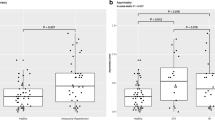Abstract
The optic nerve, ontogenetically part of the central nervous system, is surrounded by subarachnoidal cerebrospinal fluid (CSF) and dura mater. Because of the connection with the intracranial subarachnoidal space, CSF pressure variations influence the optic nerve sheath (ONS) diameter. Histologic studies revealed a segment of the optic nerve in which maximal diameter fluctuations could be expected, namely the bulging dura mater region approximately 3 mm behind the papilla. Twenty preparations of optic nerves obtained post mortem were examined sonographically before and after dilatation of the ONS, by means of measurement from three different projections. After gelatine-induced widening of the subarachnoidal space, the mean diameter increased by 60 % at 3 mm behind the optic nerve head, but only by 35 % at 10 mm distance. Independent measurements by two examiners correlated highly, which indicates excellent reproducibility of the sonographic measurements. The optimal experimental scanning position was at a right angle to the optic nerve (longitudinal section). Under clinical conditions, however, only axial sections can be obtained using anterior probe positions with transbulbar sound directions. Using such axial projections the 3 nm7 position proved reliably reproducible. The reduced resolution of the optic nerve itself, allowing it to be distinguished from its surrounding sheath, proved to be somewhat disadvantageous from this projection angle.
Similar content being viewed by others
References
Marshall LF, Bowers-Marshall S, Klauber MR, et al (1991) A new classification of head injury based on computerized tomography. J Neurosurg 75: 14–20
Murphy A, Teasdale E, Matheson M, Galbraith S, Teasdale G (1983) Relationship between CT indices of brain swelling and intracranial pressure after head injury. In: Ishii S, Nagai H, Brock M (eds) Intracranial pressure, vol 5. Springer, Berlin Heidelberg New York, pp 562–563
Toutant S, Klauber M, Marshall L, et al (1984) Absent or compressed basal cisterns of first CT scan: ominous predictors of outcome in severe head injury. J Neurosurg 61: 691–694
Van Dongen K, Braakmann R, Gelpke GJ (1983) The prognostic value of computed tomography in comatose headinjured patients. J Neurosurg 59: 951–957
Ghajar JBG (1986) A guide for ventricular catheter placement. Technical note. Neurosurgery 63: 54–59
Powell MP, Crockhard HA (1985) Behavior of an extradural pressure monitor in clinical use. Comparison of extradural with intraventricular pressure in patients with acute and chronic intracranial pressure. J Neurosurg 63: 745–749
Ostrup RC, Luerssen TG, Marshall LF, Zornow MH (1987) Continuous monitoring of intracranial pressure with a miniaturized fiberoptic device. J Neurosurg 67:206–209
Barlow P, Mendelow AD, Lawrence AE, Barlow M, Rowan JO (1985) Clinical evaluation of two methods of subdural pressure monitoring. J Neurosurg 63:578–582
North B, Reilly P (1986) Comparison among three methods of intracranial pressure recording. Neurosurgery 18: 730–732
Aucoin PJ, Kotilainen HR, Gantz NM, et al (1986) Intracranial pressure monitors: epidemiologic study of risk factors and infections. Am J Med 80: 369–376
Anders K, Becker GW, Jäger M, Krüger O (1971) Die Abhängigkeit mechanischen Verhaltens menschlicher Faszie von Faserverlauf, Alter und Konservierung. Arch Orthop Unfallchir 69: 246–263
Anders K, Häring R, Krüger O, Steigerthal I, Pickartz H, Zühlke H (1979) Bis zu welchem Zeitpunkt post mortem ist die Entnahme allogener Venen für den Gefässersatz vertretbar? Vasa 8: 122–128
Byrne SF (1978) The echographic measurement and differential diagnosis of optic nerve lesions. In: Ossoinig KC (ed) Ophthalmic echography. (Doc Ophthalmol Proc series, vol 48) Nijhoff/Junk, Dordrecht, pp 571–585
Coleman DJ, Carolli FD (1972) Evaluation of optic neuropathy with B-scan ultrasonography. Am J Ophthalmol 74: 915–920
Ossoinig KC, Cennamo G, Byrne SF (1981) Echographic differential diagnosis of optic-nerve lesions. In: Thijssen JM, Verbeek AM (eds) Ultrasonography in ophthalmology. (Doc Ophthalmol Proc series, vol 29) Junk, The Hague, pp 327–332
Skalka HW (1981) Ultrasonography of the optic nerve. Neuroophthalmology 4: 261–272
Schröder W, Guthoff R (1981) Ultrasonography of the optic nerve. In: Thijssen JM, Verbeek AM (eds) Ultrasonography in ophthalmology. (Doc Ophthalmol Proc series, vol 29) Junk, The Hague, pp 359–362
Ossoinig KC (1993) Standardized echography of the optic nerve. In: Till P (ed) Ophthalmic echography, vol 13. Kluwer Academic, The Netherlands, pp 3–99
Guthoff R, Triebel G, Schröder W, Onken C, Abramo F (1990) Evaluation of the subarachnoidal space — comparisons between ultrasound and high resolution NMR-techniques. In: Sampolesi R (ed) Ultrasonography in ophthalmology, vol 12. Kluwer, Dordrecht, pp 55–62
Author information
Authors and Affiliations
Rights and permissions
About this article
Cite this article
Helmke, K., Hansen, H.C. Fundamentals of transorbital sonographic evaluation of optic nerve sheath expansion under intracranial hypertension. Pediatr Radiol 26, 701–705 (1996). https://doi.org/10.1007/BF01383383
Received:
Accepted:
Issue Date:
DOI: https://doi.org/10.1007/BF01383383




